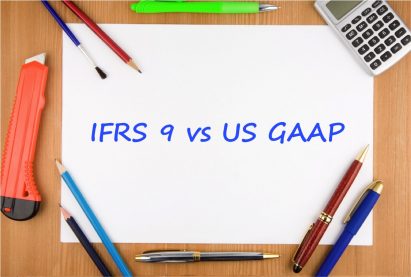IFRS 9 Financial Instruments Explained (2025): Full Guide + Free Practical Checklist
Updated: May 2025 IFRS 9 sets the rules for classification, measurement, impairment, and hedge accounting of financial instruments. This practical guide simplifies the key principles, with a free video summary and a downloadable IFRS 9 Practical Checklist (2025 Edition). Jump to section: 1. Free VIDEO…
How to Implement IFRS 9
The new IFRS 9 Financial Instruments will replace the older standard IAS 39 in January 2018 and it practically means that if you are affected, you need to start getting ready NOW. Why? Because your comparative period starts in January 2017 and you will need…
IFRS 9 vs. US GAAP – Coming Closer?
We all know that IASB and US standard’s setting body FASB work together in order to prepare a single set of global accounting standards. Recently issued standard on revenue recognition, IFRS 15 and its American counterpart FAS 606 are a good example of these mutual…
Hedge Accounting Under IFRS 9: Rebalancing – What Is This New Concept?
Hedge accounting belongs to the most difficult accounting areas and I published a few articles on this topic on IFRSbox – for example, here and here. Today, I’m delighted to present another hedging article written by Mr. Kevin Mitchel,Partner – Advisory Services at Rochford, the…
The Best of CPDbox 2015
The year-end is coming closer and closer; the closings have already started to push their pressure on all of us, the exam season approaches and we live the busy lives. I know that this part of the year is usually the second busiest for any…
The Quick Guide to IFRS 7 Risk Disclosures
The financial instruments belong to the most complicated and difficult areas in IFRS and therefore, I dedicated many articles to making the things understandable a bit. However, until now, we haven’t even touched the complexity of the disclosures about financial instruments as required by IFRS…
Current or Non-Current?
Most balance sheets present individual items in distinction to current and non-current (except for banks and similar institutions). This seems so basic and obvious that most of us do not really think about classifying individual assets and liabilities as current and non-current. We do it…
How to Account for Employee Loans (interest-free or below-market interest)
After I wrote an article about capitalizing borrowing cost, I got a lot of e-mails asking me actually HOW to account for loans that do not bear the interest rate reflecting market conditions. In other words, how to account for loans at below-market interest rate,…
IFRS for Banks and Financial Institutions
If you work for a bank or any other financial institution, then you are very well aware of the fact that IFRS is a little bit different there. OK, not quite like that: IFRS is still the same, just the way how you use it…
How Ignoring Hedging Can Hurt Your Business
Hedge accounting has a reputation as being one of the most difficult areas for people to get to grips with, which is a shame because it is a very useful accounting “technology”. You can find several articles related to basics of hedge accounting in line…
Recent Comments
- Albert on Accounting for gain or loss on sale of shares classified at FVOCI
- Chris Kechagias on IFRS S1: What, How, Where, How much it costs
- atik on How to calculate deferred tax with step-by-step example (IAS 12)
- Stan on IFRS 9 Hedge accounting example: why and how to do it
- BSA on Change in the reporting period and comparatives
Categories
- Accounting Policies and Estimates (14)
- Consolidation and Groups (25)
- Current Assets (21)
- Financial Instruments (56)
- Financial Statements (54)
- Foreign Currency (9)
- IFRS Videos (74)
- Insurance (3)
- Most popular (7)
- Non-current Assets (56)
- Other Topics (15)
- Provisions and Other Liabilities (46)
- Revenue Recognition (27)
- Uncategorized (1)













